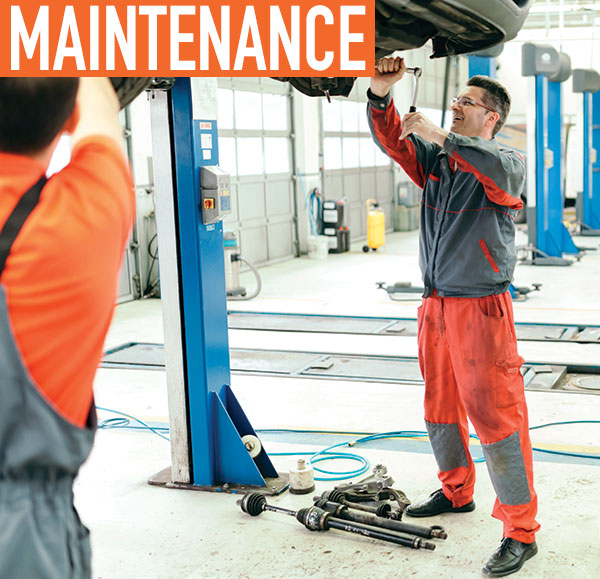Did you ever think about what kind of people you want doing preventive maintenance (PM) on your equipment? Most maintenance managers don’t give PM a second thought—except to find the time to complete the work. In fact, having the right kind of people in the PM loop can make a real difference.
TRUE STORY
You’ll laugh and say it would never happen in your shop but this really happened to me: An automobile mechanic does a PM to a two-month old car on a service request that the car would stall. The stalling problem was presumed to have been handled. In fact, no one else had looked at this vehicle.
The mechanic cleaned the terminals of the battery—which was a task in this PM routine. He didn’t notice that the battery hold down was gone. The battery had shifted in the holder so that the positive terminal had shorted against the chassis. The shorted battery boiled over and spilled acid on the wiring harness. This caused the harness insulation to be degraded to the point that exposed copper could be seen.
If the owner hit a bump, the harness would shift and the car would stall. It takes something to miss all that damage. The service writer was in shock when shown what was passed as complete.
What went wrong here? Besides the communication problem that the problem had not been handled, the PM person was asleep at the wheel. Have you ever done PM for eight hours? PM is pretty tough work, maybe the toughest in your shop.

GETTING PM DONE
One of the toughest problems to solve is how to insure the inspector is actually doing the inspection on the task list. Horror stories about maintenance catastrophes frequently feature task lists that were signed as completed, but were obviously not performed. The consequences of PM not being done on a truck could be deadly.
For most people, PM tasks are boring and mind numbing. The challenge of leadership is to inspire the people in PM roles to want to do the tasks well. The ideal inspector can be a regular mechanic, operator, helper (if appropriate) on a part-time basis, or a full-time PM technician.
Here are some ways to make sure PM gets done correctly, the first time:
- Make sure the inspector knows how the PM activity fits into the overall scheme. Is it well known that PM impacts reliability, safety, costs, and output?
- Drag your top management down to the shop and have them address the maintenance crews about the criticality of PM, safety, and uptime. You might have to write the speech. People attend to what they think management thinks is important.
- Let them hear it from the horse’s mouth.
- Present the job as important. If people feel that PM is stupid, boring, and low priority fill-in work, they are less likely to put themselves out.
- One of the most important things you can do to insure the work is done is to let your PM mechanics themselves design the system and tasks.
- One hole in PM is lack of specific skills. An individual might be lacking a specific item of skill or knowledge to effectively perform the task. Be explicitly sure the PM people are fully trained. Keep them going to school to learn the latest of the latest.
- Improve the relationship between the mechanic and the driver. Instruct the mechanic to make personal contact. Some PM task lists include, “Talk to operator and determine if equipment has operated normally since the last visit.” If there is not a task like this, add one.
- Make it easy to do tasks. Re-engineer equipment to simplify tasks and route the people to minimize travel when possible.
- Simplify paperwork.
- Improve accountability by mounting a sign-in sheet inside the door to the vehicle. Be sure the people who do the tasks sign a form and are included in discussions about the vehicle. When people know they might be quizzed about an asset, they are more likely to complete their PM tasks. When people know that an inquiry is conducted after a breakdown and the PM sheets are reviewed, it motivates them to complete their tasks.
- Make PM a game. One supervisor got a small amount of money, went to the local fast food restaurant, and bought $.50 gift certificates. Each week, he hid eight, three-by-five cards (that said “see me”) inside equipment on the PM list. He traded the cards for the certificates. He knew that when a card wasn’t found, PM wasn’t done. His comment was, “What people would do for $.50, they wouldn’t do for $27.50 per hour.”
- PM professionals like new, better toys—sorry, better tools not toys. Technology has opened up the field for sophisticated, relatively low-cost PM tools. They might include $700 for a pen-size vibration monitor, $500 for a cigarette pack-size infrared scanner, or $1,500 for an ultrasonic detection headset and transducer. If appropriate to the size and type of equipment, these tools will motivate the troops and increase the probability that they will detect deterioration before failure.
- In any repetitive job, boredom sets in. Consider job rotation to improve morale.
In short, do what you can to make the important PM job work for you.
CONTRIBUTION
This article was originally published online. To see the article online, visit www.maintenancetraining.com/articlessearch and click on “Put the People into PM.” For more articles and useful content, visit www.maintenancetraining.com.
ABOUT THE AUTHOR:
Joel Levitt, director, Reliability Projects, is the author of Basics of Fleet Maintenance. He has more than 25 years of experience over a wide range of clients. Contact Levitt by email, joel.levitt@reliabilityweb.com, or visit www.reliabilityweb.com.
_______________________________________________________________________
MODERN WORKTRUCK SOLUTIONS: JUNE 2017 ISSUE
Did you enjoy this article?
Subscribe to the FREE Digital Edition of Modern WorkTruck Solutions magazine.
![]()




